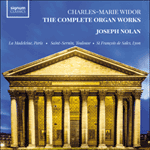
Welcome to Hyperion Records, an independent British classical label devoted to presenting high-quality recordings of music of all styles and from all periods from the twelfth century to the twenty-first.
Hyperion offers both CDs, and downloads in a number of formats. The site is also available in several languages.
Please use the dropdown buttons to set your preferred options, or use the checkbox to accept the defaults.


Placed second, and broadly unchanged in subsequent editions, the 12/8 G major Pastorale, ‘replete with grace and aural colour’ (Near), inhabits a post-Bachian/Berliozian world, somewhere between Jesus bleibet meine Freude and L’enfance du Christ. In March 1870 Ménestrel reported Widor playing ‘a beautiful fantaisie pastorale’ at Saint-Sulpice: the Pastorale of the Second Symphony, Near wonders (2011)? The ensuing Andante in B flat major is a chorale-like scena (on an anacrustic theme determined by repetitive two-quaver/two-crotchet patterns) displaying Widor’s schooled command of motivic and sequential development. Likewise his habitual pleasure in key-shifting. Scarcely has the theme been announced before we are sharing a calvados or two with D major, F sharp major, B minor, G major/minor—the start of an adventurous ramble. Anticipating the Fifth Symphony (1879), the tripartite Finale is a grand toccata—slurs and staccato as critical to its thematic profile as harmonic thrust and resolution are to its architecture.
from notes by Ateş Orga © 2012
 Widor: The Complete Organ Works Widor: The Complete Organ WorksRecorded on the Cavaillé-Coll organs (Symphonies 1-9 at La Madeleine, the other works in Toulouse and Lyon) so beloved of Widor, Joseph Nolan's mammoth survey represents an ideal marriage of composer, instrument and performer: 'Nolan’s combination ...» More |

